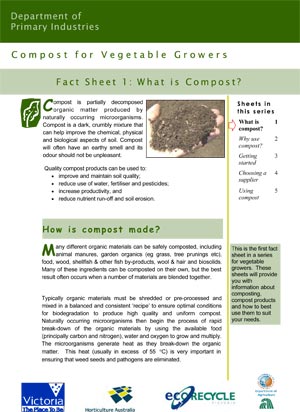|
|
This is the first in a series of five fact sheet developed for vegetable growers in 2003. These sheets will provide you with information about composting, compost products and how to best use them to suit your needs. What is Compost ?
Compost products can be used to :
Making Compost :
Quality Control :
Acknowlegements : Peter Franz, Department of Primary Industries (Victoria), Knoxfield, for providing statistical advice for the persistence of enteric bacteria on leafy vegetable trials. Dr Graham Hepworth, from the Statistical Consulting Centre at The University of Melbourne, for experimental design assistance, analysing data and providing statistical advice with regards to the persistence of enteric bacteria in poultry litter trials. Francha Horlock, Janet Tragenza (Department of Primary Industries (Victoria), Knoxfield) and Iphie Papapetrou (Box Hill Institute, Victoria) for providing technical advice and assistance. Agnes Tan and Nela Subasinghe from The Microbiological Diagnostic Unit, Department of Microbiology and Immunology at The University of Melbourne for microbial diagnostic advice and services. Dr Barry Macauley from the Department of Microbiology at Latrobe University provided valuable assistance in the interpretation of the experiments examining the reduction and persistence of enteric bacteria during aging of poultry litter. This work was funded by: Horticulture Australia Pty Ltd, Department of Primary Industries (Victoria) and the Australian Vegetable Growers through the AUSVEG levy with voluntary contributions from: VegFed (NZ), CL & AK Warlan, Lightowler Fowl Manure Pty Ltd, TD & EC Ould Pty Ltd |
||||||||
|

